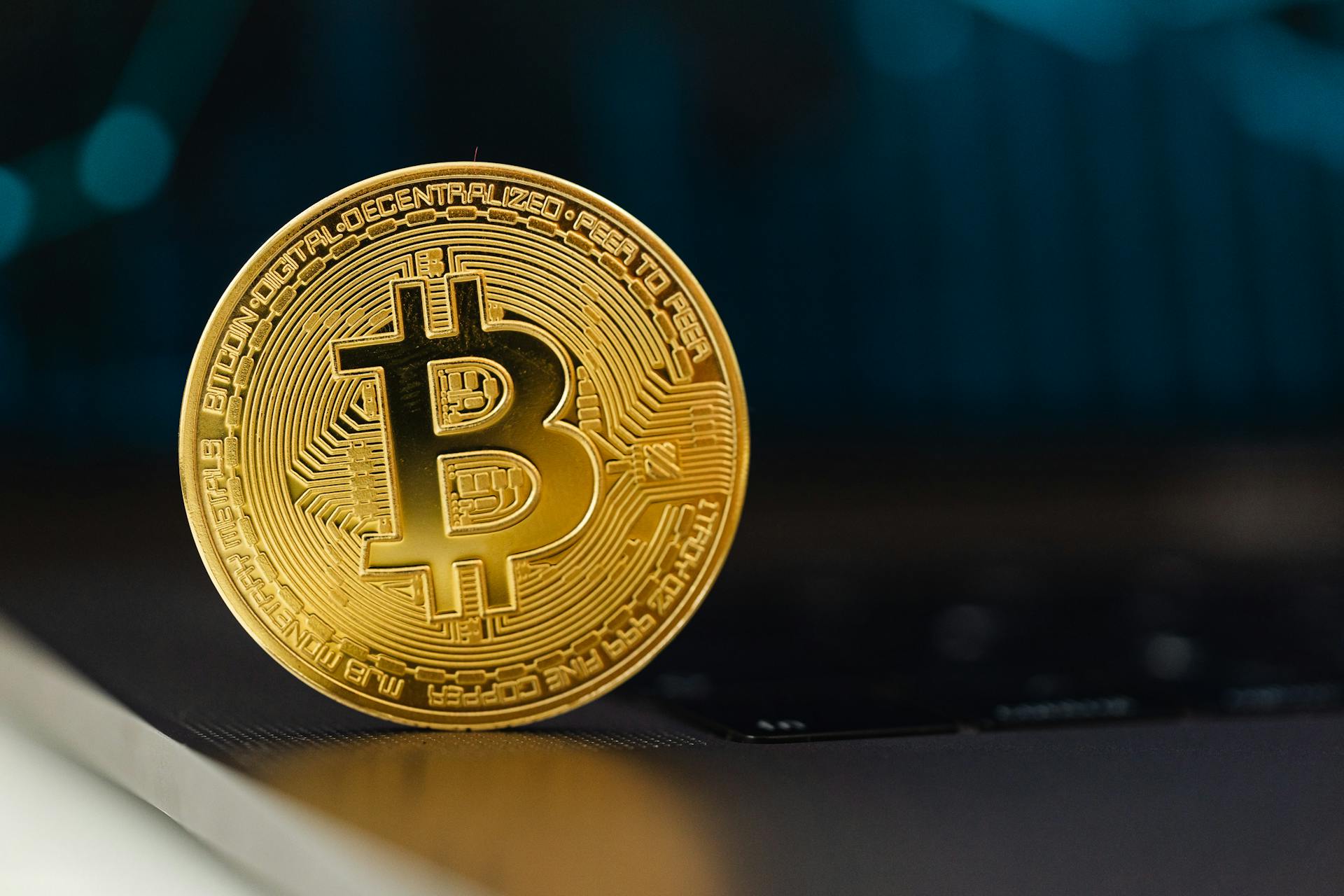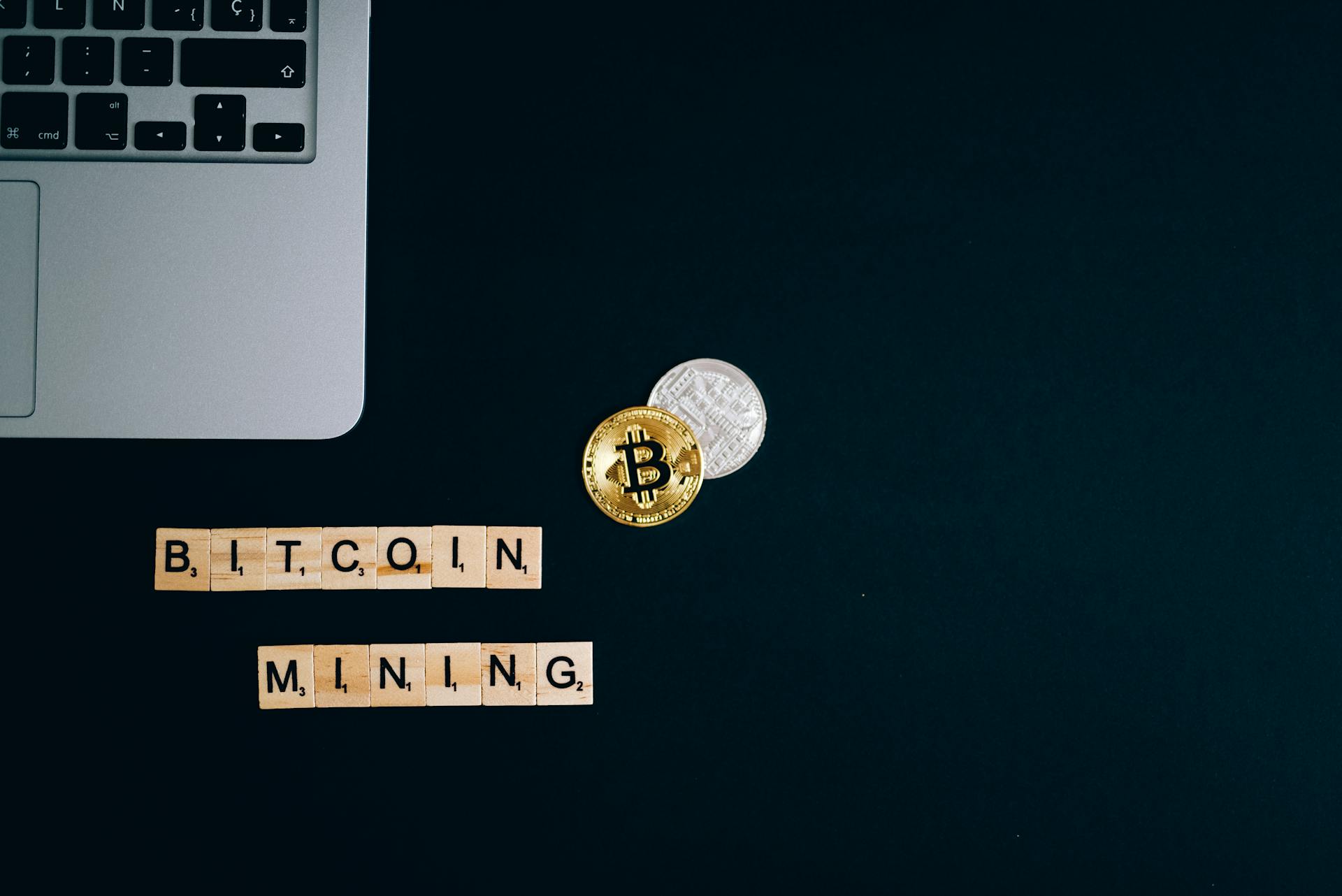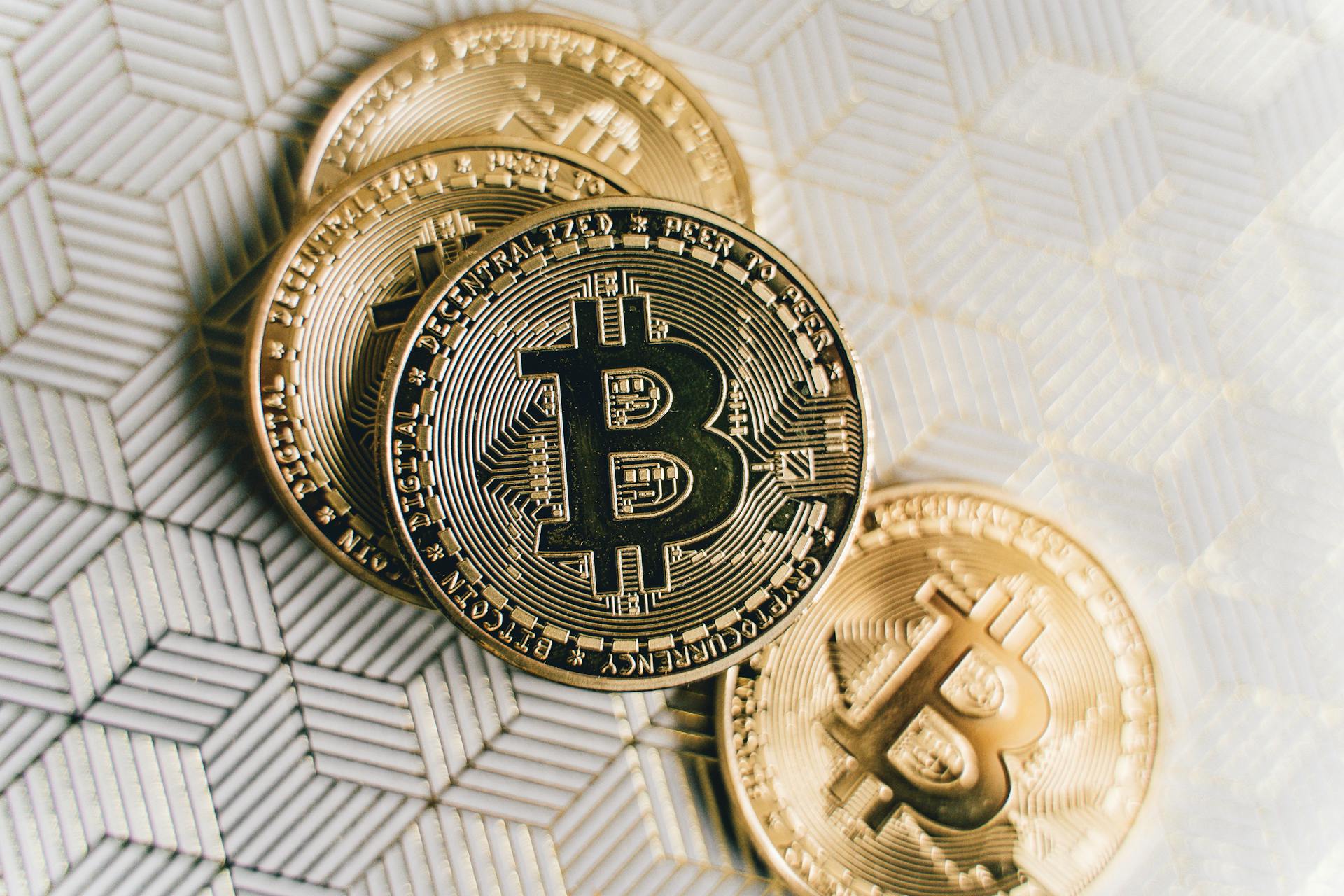
Bitcoin's blockchain is a decentralized, digital ledger that records all transactions made with the cryptocurrency. It's like a digital bookkeeping system that's maintained by a network of computers around the world.
Each block in the blockchain contains a list of transactions, and once a block is added, it can't be altered. This ensures the integrity and transparency of the entire system.
The blockchain is made up of a chain of blocks, each linked to the one before it, creating a permanent and unalterable record.
What is Bitcoin's Blockchain
Bitcoin's blockchain is a decentralized digital ledger that records all transactions made with the cryptocurrency. It's a public record that's maintained by a network of computers around the world.
The blockchain is made up of blocks, which are linked together in a chain, hence the name. Each block contains a list of transactions.
These transactions are verified by special kinds of computers called nodes, which help to ensure that the transactions are legitimate. This process is called mining.
The blockchain is decentralized, meaning that it's not controlled by any single entity, but rather by a network of computers that work together to maintain it.
Check this out: Bitcoin Network
How it Works
The Bitcoin blockchain is a complex system, but understanding how it works is actually quite fascinating.
To start the process, a network of computers, known as miners, work together to validate and record transactions.
These miners use powerful computers to solve complex mathematical problems, which helps to secure the network and verify transactions.
The process of solving these mathematical problems is called mining, and it requires a lot of computational power.
As miners solve these problems, they are rewarded with a certain number of new Bitcoins, which is how new Bitcoins are created.
This process is what allows the Bitcoin blockchain to grow and expand, with new blocks being added to the chain every 10 minutes.
Additional reading: New Blockchains
Key Concepts
In the world of blockchain technology, there are several key concepts to understand.
A blockchain is essentially a chain of blocks, with each block containing a cryptographic hash that links it to the most recent block, a notation of the time, and a record of transaction information.
Each block is added to the existing chain in chronological order, allowing for accurate, transparent, and permanent records.
Mining is the process of updating the blockchain by adding blocks and creating new coins. This requires high-level computing power and advanced equipment.
Miners validate transactions by solving cryptographic hash puzzles, and they're often rewarded with Bitcoins or other cryptocurrencies for their efforts.
A node in blockchain technology is a computer that runs blockchain software and has access to the blockchain. Every node updates with the latest version of the blockchain, creating a decentralized record of all transactions.
Here's a quick rundown of the key concepts:
- Blocks: A chain of blocks, each containing a cryptographic hash, time notation, and transaction information.
- Mining: The process of updating the blockchain by adding blocks and creating new coins.
- Nodes: Computers that run blockchain software and have access to the blockchain.
Mining and Nodes
Bitcoin mining is a complex process of validating transactions over the Bitcoin network. It's a way to verify a block of transactions and get paid in Bitcoin.
Miners use computers with incredible computing power to solve the block mathematically, and the first miners to solve the block are rewarded with bitcoin. This process is called proof of work, which has a broad goal to prevent cyber attacks from any single entity or group.
The Secure Hash Algorithm 256 bit (SHA-256) is used to generate an output, referred to as a "hash." Hashing is used to solve the mathematical problem, in which the end answer is the known and expected hash value.
There are two types of nodes in the Bitcoin network: full nodes and light nodes. A full node synchronizes the blockchain by downloading the whole chain, from the genesis block to the current block. A light node does not download the entire chain, but can still effectively verify transactions.
Here are the main differences between full nodes and light nodes:
Miners typically run a full node to validate and relay Ethereum transactions effectively, and all nodes participate in the consensus process.
Confirmation Difficulty
Confirmation Difficulty is a key aspect of the Bitcoin network. It's designed to ensure that the average block confirmation time takes ten minutes, which is achieved by adjusting the complexity of the puzzle every 2,016 blocks.
The puzzle's complexity can change in a way that makes it easier to solve, but this is rare. Usually, the problems become more challenging, making it expensive and time-intensive to confirm blocks.
Initially, Bitcoin mining could be done using consumer-grade computing chips. However, due to the increase in difficulty, mining now requires enormous hashing power. This has led to the use of application-specific integrated circuit (ASIC) chips, which are customized for Bitcoin mining.
These ASIC chips are incredibly expensive, resulting in a select group or pool of miners dominating the lion's share of the Bitcoin mining activity.
You might enjoy: Bitcoin Halving Cuts in Half the Reward for Mining Bitcoin.
Minning
Mining is the process of validating Bitcoin transactions over the Bitcoin network. It's a complex computational and technological process that involves solving complex hash puzzles to verify blocks containing transactions.
Miners compete against each other to solve these puzzles, and the first miner to guess the number gets to update the ledger of transactions on the Bitcoin blockchain network and receives a reward for newly minted Bitcoins. Miners use powerful computers to make guesses, with more powerful computers allowing for more guesses per second.
Miners can choose to mine solo or join a mining pool, which combines the computing power of multiple miners to increase efficiency and reduce mining difficulty. A mining pool promotes participation from small miners, who can still earn a share of the reward.
The maximum amount of Bitcoin that can be created or mined is 21 million. Miners invest electrical power to generate or create Bitcoins, and the process of mining is often compared to actual mining for natural resources.
Miners verify legitimate transactions and create new Bitcoin as a reward for their work. They use a protocol called proof of work, which prevents cyber attacks from any single entity or group.
The process of mining involves solving a cryptographic (mathematical) puzzle, which is used to prevent counterfeiting and double-spending. Miners use the Secure Hash Algorithm 256 bit (SHA-256) to generate an output, which is referred to as a "hash."
Here are the primary reasons for Bitcoin mining:
- To bring new coins into circulation and validate ongoing transactions.
- To check counterfeiting and double-spend.
- To maintain the ledger in a decentralized manner.
GPU
GPU mining emerged as a more efficient option than CPU mining, thanks to graphics processing units' better hash rate.
The first software for GPU mining was launched in 2010, marking a significant shift in the mining landscape.
GPU-based systems, which were initially used for gaming and video editing, proved to be a game-changer for miners.
However, GPU mining was short-lived, as it was eventually replaced by ASICs by 2015.
Take a look at this: Mining Bitcoin Meaning
Two Types of Nodes
There are two types of nodes in the Ethereum network, and understanding the difference between them is crucial for effective participation.
A full node synchronizes the blockchain by downloading the whole chain, from the genesis block (first block) to the current block.
A light node does not download the entire chain, but can still effectively verify transactions.
Both full and light nodes are essential for the Ethereum network to function smoothly.
Miners typically run a full node to validate and relay Ethereum transactions effectively.
All nodes, whether run by miners or non-miners, participate in the consensus process by executing validation and relay.
Intriguing read: Ethereum Chain
Payment Processing
Payment Processing is where blockchain really shines. It can make transactions more efficient by streamlining international and domestic transactions. This can reduce transaction fees and increase transparency.
Visa has already shown the potential of blockchain technology for mainstream use since adopting it for international business payments in 2017. This is a big deal, as it opens up new possibilities for secure and efficient financial transactions.
Blockchain technology can also process and record transactions securely, as seen in the use of blockchain in cryptocurrency. This ensures transparency and protects the financial information and identity of crypto buyers and sellers.
Understanding the Process
A blockchain is a digital data structure that creates a digital ledger of transactions and shares it among a distributed network of computers. This ledger is like a general ledger where all cryptocurrency transactions are recorded.
Each block in the blockchain stores transactions added to it only once miners verify and validate them. This makes it impossible to change the transactions as they are already on the blockchain.
If this caught your attention, see: Cryptocoin Ledger
The Bitcoin blockchain network uses the latest cryptographic algorithm techniques of SHA-256, which converts data into a unique string of characters. This ensures the integrity of the transactions.
Transactions initiated in the Bitcoin network are bundled together using the SHA-256 encryption, creating a Merkle tree or hash tree. Each leaf node represents a block's hash, and non-leaf nodes have the hash of their child nodes.
The proof-of-work (PoW) algorithm organizes the transaction data into blocks with an address of their own. To be a validated block, it must contain PoW, which ensures that the blocks are mined at a specific speed while maintaining their integrity.
The network decides the specific target hash after every 2,016 blocks, with the aim of maintaining the difficulty of mining so that a block gets mined every 10 minutes on average. This difficulty of Bitcoin mining measures how difficult it is to find a hash below the target value.
A miner constantly focuses on the string of numbers appended to the hashed contents of the previous block. If this new hash is equal to or less than the target hash, it is accepted as the solution.
The block reward for cracking the hash first is currently 3.125 BTC per block, and the miner also gets the ability to authorize the transaction on the blockchain.
You might like: How Does Bitcoin Mining Work
Types and Advantages
Blockchains offer several advantages, including anonymity, cost reduction, and increased privacy. This is achieved through the use of pseudonyms and encrypted data.
One of the key benefits of blockchain technology is its ability to reduce costs associated with international transactions. This is due to lower transaction fees, reduced need for intermediaries, and automated smart contracts.
Here are some of the advantages of blockchain technology:
- Anonymity: Transactions can be made under pseudonyms without being attached to your identity.
- Cost reduction: Lower transaction fees, reduced need for intermediaries, and automated smart contracts.
- Decentralization: Records remain consistent across locations and countries.
- Increased privacy: Data is encrypted and private key authentication is used to protect user-specific information.
- Permanent records: Data records stay forever due to cryptographic signatures and the decentralized nature of the blockchain.
- Security: Hackers cannot disrupt or corrupt the data, and the blockchain is continually updated to nodes worldwide.
- Streamlined processes: Smart contracts with blockchain reduce the steps to complete a transaction and process payments quickly.
Some Advantages
Blockchain technology has several advantages that make it an attractive solution for various industries.
One of the key benefits is anonymity, which allows users to create transactions under pseudonyms without being attached to their identity.
This can be particularly useful for people who value their privacy, such as those in sensitive professions.
Blockchain technology can also potentially reduce the cost of international transactions, thanks to lower transaction fees, reduced need for an intermediary, and automated smart contracts.
This can be a significant advantage for businesses that frequently conduct cross-border transactions.

The decentralized nature of blockchain means records remain consistent across locations and countries, diminishing discrepancies in data and ensuring professionals have access to the same information.
This can lead to increased trust and cooperation among stakeholders.
Here are some of the key advantages of blockchain technology:
These advantages make blockchain technology an attractive solution for various industries, from finance to healthcare.
Types of
There are several types of Bitcoin mining, each with its own level of hashing power and block rewards.
Centralized mining pools are a popular way to mine Bitcoin, as they allow individuals to pool their resources and increase their chances of solving complex mathematical equations.
Cloud mining is another option, where users rent computing power from a cloud-based service provider and receive a share of the mined Bitcoins.
Home-based mining, also known as solo mining, is a more personal approach where individuals use their own computers to mine Bitcoin.
ASIC mining is a specific type of mining that uses Application-Specific Integrated Circuit chips, designed specifically for Bitcoin mining, to deliver high levels of hashing power.
Take a look at this: Does Chainlink Have Its Own Blockchain
Sources
- https://www.pwc.com/us/en/industries/financial-services/fintech/bitcoin-blockchain-cryptocurrency.html
- https://www.bankrate.com/investing/what-is-bitcoin-mining/
- https://www.coursera.org/articles/blockchain-cryptocurrency
- https://consensys.io/knowledge-base/how-does-a-blockchain-work
- https://www.forbes.com/advisor/in/investing/cryptocurrency/how-are-bitcoins-mined/
Featured Images: pexels.com


